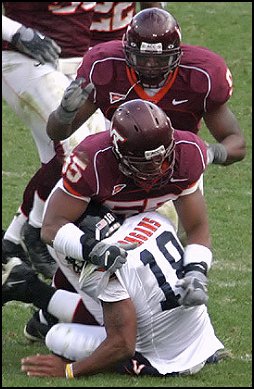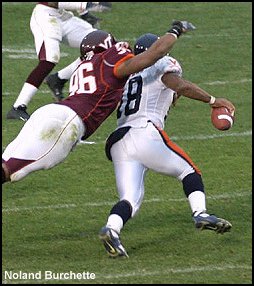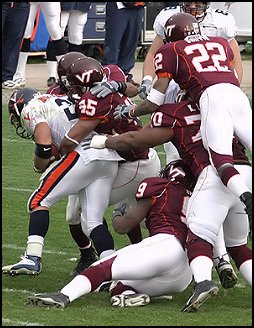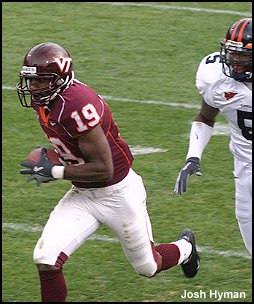 In preparing the “Keys to the Game”
articles, I break down the individual matchups to identify the two or three that
will have the biggest impact on the game. It’s basically a checklist of player
matchups and position matchups. For the first time since I started writing these
articles, the other guys had more checks in their column than did Tech. While I
draw no conclusions simply from that list, the math was a cause for concern and
one that I couldn’t ignore in my own mind as I entered Lane Stadium on
Saturday. Needless to say, I walked out of Lane Stadium feeling much better.
In preparing the “Keys to the Game”
articles, I break down the individual matchups to identify the two or three that
will have the biggest impact on the game. It’s basically a checklist of player
matchups and position matchups. For the first time since I started writing these
articles, the other guys had more checks in their column than did Tech. While I
draw no conclusions simply from that list, the math was a cause for concern and
one that I couldn’t ignore in my own mind as I entered Lane Stadium on
Saturday. Needless to say, I walked out of Lane Stadium feeling much better.
The outcome of this game revealed the basic flaw in
reading too much into a checklist of matchups – all matchups are not created
equal and some can be more easily exploited than others. Tech proved that point
against UVa, utilizing their speed advantage on defense while exploiting the
weaknesses in UVa’s secondary for two big plays that were the difference in
the game.
Tech Defense vs. Virginia Offense
Going in, everyone knew that UVa wanted to establish the
run and Tech’s top priority on defense was to stop the run and force QB
Marques Hagans to win the game by throwing the ball. In the end, the Tech
defense prevailed, holding UVa’s high powered offense under 300 yards for only
the second time this season.
The difference in this matchup was speed. Tech’s
quickness up front and speed outside were tough for an offense that relies on
athletic linemen beating defenders to the spot and a quarterback that uses his
mobility to break containment. In this game, with the exception of a couple of
plays, UVa was unable to dictate play behind their running game or spring Hagans
on big plays with run/pass options.
Key #1: Penetration by Defensive Line
 In the pre-game analysis, penetration was identified as
the most critical key for the Tech defense in this game. Led by Jim Davis, the
defensive line used superior speed and quickness to consistently penetrate the
line of scrimmage, cutting off the running lanes for RB Alvin Pearman. Davis’
quick first step off the ball created problems inside for UVa throughout the
game. It was the penetration by Davis and Jonathan Lewis that disrupted the
timing of the handoff between Hagans and RB Wali Lundy, resulting in the rare
UVa turnover and first major turning point in the game.
In the pre-game analysis, penetration was identified as
the most critical key for the Tech defense in this game. Led by Jim Davis, the
defensive line used superior speed and quickness to consistently penetrate the
line of scrimmage, cutting off the running lanes for RB Alvin Pearman. Davis’
quick first step off the ball created problems inside for UVa throughout the
game. It was the penetration by Davis and Jonathan Lewis that disrupted the
timing of the handoff between Hagans and RB Wali Lundy, resulting in the rare
UVa turnover and first major turning point in the game.
As in their previous games, UVa used a lot of two and
three TE formations, with Tom Santi lined up as a fullback or as an H-back. The
quickness of Tech’s defensive ends and linebackers created problems for UVa’s
tight ends and offensive tackles in the run game. UVa had some success when they
were able to isolate a more athletic tight end on a Tech defensive end, but that
often freed up a Tech linebacker or Rover James Griffin in pursuit.
Noland Burchette’s speed and quickness surprised UVa and
he had two of the bigger defensive plays in the game. On the goal line stand, it
was Burchette that came down the line to meet Pearman before he got back to the
line of scrimmage, easily beating the block attempt by fullback Tom Santi.
Burchette was just too quick collapsing down on that play and Santi couldn’t
get to him in time.
Burchette also made a great individual play to seal the
game with the strip of Hagans that resulted in UVa’s second turnover. On that
play, Burchette beat tackle D’Brickashaw Ferguson’s pass block and chased
down Hagans from the backside. Ferguson is one of the better tackles in college
football, but he struggled with Burchette’s quickness and speed.
Key #2: Contain Marques Hagans
 Hagans' ability to make plays with his legs as well as his
arm was a big concern heading into the game. The defense did an excellent job
keeping Hagans under wraps, again using speed and quickness to keep him bottled
up.
Hagans' ability to make plays with his legs as well as his
arm was a big concern heading into the game. The defense did an excellent job
keeping Hagans under wraps, again using speed and quickness to keep him bottled
up.
Tech played a lot of 8-man fronts in this game, rolling
the Rover up in run support and sliding the Whip to primary containment
responsibility against Hagans. UVa had difficulty accounting for the extra
defender and when Hagans looked to get outside, James Anderson and Aaron Rouse
were there to close him off.
Bootlegs had been a big part of UVa’s success in earlier
games, but they had limited success against the Hokies defense. The scheme with
the four linebacker sets provided natural horizontal containment against Hagans’
run option off the bootleg, while allowing the extra defender to zone underneath
against his pass options to the flat. Depending on ball position, formation and
personnel, this extra defender was Whip LB (Anderson or Rouse), Rover James
Griffin or boundary corner Jimmy Williams. All created unique matchup problems
for UVa’s offense and was one of the primary reasons that UVa didn’t try a
lot of bootlegs in this game.
One that they did try was on the big third and goal play
in the third quarter. Hagans ran the bootleg to the boundary with Elton Brown
leading him out front. Jimmy Williams came off the corner to take on Brown’s
block up the field to force Hagans to take the play further outside that he
wanted. By stringing it out, Williams bought time for James Anderson to come out
of his underneath zone and chase Hagans down before he could reach the end zone.
This was yet another example of Tech’s penetration, pursuit and defensive
speed neutralizing one of UVa’s quickest players, resulting in a negative play
for the Cavalier offense.
(A side note….I saw where that play was intended to be a
throwback screen to RB Wali Lundy. That option was cutoff early by the backside
penetration of Xavier Adibi and corner Eric Green staying home in coverage.
Coming out of play action, Lundy stopped and never ran his route backside. For
his part, Hagans never looked towards Lundy. His pass options were TE’s Heath
Miller and Patrick Estes, but both were well covered and the penetration by the
Tech defense cut off most of Hagans’ passing lanes.)
Key #3: Win First Down
With the exception of Pearman’s big 78 yard run, Tech’s
defense did an excellent job defending first down. UVa insisted on running the
ball, in spite of the fact that they had single coverage outside on the wide
receivers for much of the game. That tells me that the UVa coaches were not
confident in the matchups of Michael McGrew and Deyon Williams against the Tech
corners, particularly with Williams still recovering from injuries.
Tech also did a good job zoning and bracketing coverage
against TE Heath Miller. When he did get open, the penetration up front closed
off passing lanes and magnified the problems of a shorter QB that has trouble
seeing over the line clutter in front of him.
Key #4: Rovers Solid against the Run and Pass
Tech played a lot of 4-4 looks, with Rover James Griffin
up and aligned as fourth linebacker. It was a numbers game that Tech’s defense
was willing to play in order to stop the UVa power running attack. UVa was
forced to either leave the extra defender (Griffin most of the time) unaccounted
for in the blocking scheme or decide to single block inside against one of Tech’s
defensive tackles. When unaccounted by the blocking scheme, the extra defender
was free to pursue down the line or shoot a gap to close off cutback lanes. Tech’s
defensive line was getting too much penetration, even against double team
blocks, so UVa needed Alvin Pearman to beat the one defender unaccounted for by
the blocking scheme. That was a tall order, considering the quickness of the
Tech defense in pursuit.
Key #5: No Big Plays
The defense held the UVa offense in check for most of the
game, giving up two big plays to RB Alvin Pearman. In the first quarter, Pearman
broke off a 78 yard run that would have gone the distance if not for an
incredible athletic play by Jimmy Williams. Pearman is one of UVa’s fastest
players and Williams came from the other side of the field to run him down. The
play sprung when the right side of UVa’s line sealed down on DE Chris Ellis
and LB Xavier Adibi took a bad angle on Pearman. Vinnie Fuller also did a poor
job in run support on the play, showing that he is still struggling with that
shoulder injury.
 The second big play was on the TD pass from Hagans to
Pearman in the third quarter. Like last year, Pearman scored on the wheel route,
showing his great athleticism and good hands by leaping over Jimmy Williams in
the end zone for the catch. As it turns out, Williams almost saved the defense
from a bad coverage call, where the coaches called the wrong coverage for the
personnel on the field at the time. Tech ran a zone blitz with Darryl Tapp
dropping into coverage; however, the improper call left Tech rushing only three
defenders, giving Hagans time to find Pearman behind the coverage.
The second big play was on the TD pass from Hagans to
Pearman in the third quarter. Like last year, Pearman scored on the wheel route,
showing his great athleticism and good hands by leaping over Jimmy Williams in
the end zone for the catch. As it turns out, Williams almost saved the defense
from a bad coverage call, where the coaches called the wrong coverage for the
personnel on the field at the time. Tech ran a zone blitz with Darryl Tapp
dropping into coverage; however, the improper call left Tech rushing only three
defenders, giving Hagans time to find Pearman behind the coverage.
UVa also got a big play with Heath Miller running a pick
route with the umpire in the middle of the field. That’s a designed play that
gets officials knocked down on occasion – in this case, the umpire was run
over by James Anderson, who recovered to make the tackle, but only after Miller
had taken the ball inside the ten yard line.
Tech Offense vs. Virginia Defense
Like UVa, Tech came in looking to establish the running
game. They also were intent on going after the UVa corners with short passes to
the flats and deep passes to the outside areas of the Cover-2 between the
corners and safeties. Specifically, Tech was looking to establish the run,
attack Darryl Blackstock when he was isolated in coverage out in the slot,
attack the middle of the field underneath the LB drops, and attack corner Tony
Franklin, both underneath and over the top.
Early on, the offense kept the big picture in mind,
playing the field position game and protecting the strong performance by the
defense. After going scoreless in the first half, the offense made a couple of
subtle adjustments that sprung the big second half performance. The first was to
throw more on first down, when UVa was in their base 3-4 defense versus throwing
against their “flex” 4-3 or nickel package on the later downs. The second
was to open things up a little more for Bryan Randall to take control of the
game, both by running and passing.
In the overall analysis, this was an excellent performance
by the offense. That group has made a tremendous amount of progress since the
beginning of the season and it starts with a senior QB that is playing at a high
level with a lot of confidence. The group of five young receivers has become a
true weapon, the offensive line has started to click as a group, and the trio of
running backs provides the power and quickness balance needed to keep defenses
honest.
Key #1: Will Montgomery vs. Andrew Hoffman
Watching the game in person, I thought Hoffman was getting
the better of Montgomery, particularly in the first half. After watching film,
that wasn’t the case. Montgomery really played well, combining with Jason
Murphy or James Miller on double teams to dictate play against one of the best
interior defensive linemen in the country. Hoffman was much more effective when
UVa flexed to a 4-3 look, getting Hoffman in single blocks against one of the
Tech guards. He was far too quick in that matchup and created problems for Tech’s
offense on several plays out of that alignment.
Montgomery’s excellent play throughout the game
culminated in a great individual effort that sprung Cedric Humes for the final
TD. Everyone has seen the breakdown of his rare double block feat, neutralizing
both Andrew Hoffman and Ahmad Brooks with separate blocks on the same play.
There’s nothing more that I can add here, other than to say it was a great
play by a player that had a great day.
One other note about that play….it was on one of Tech’s
favorite running plays that included the reverse action with a WR. While
Montgomery was taking out two players with his blocks, the reverse action took
out two other defenders. LB Darryl Blackstock stayed upfield and played
containment on the reverse, while CB Marcus Hamilton followed the receiver
across and ended up running himself right out of the play. One blocker and a
simple counter action took out four defenders. That’s the definition of a good
play.
Key #2: Get Randall to the Edge
 Tech didn’t get Randall to the edge often, running one
option play in the first quarter that isolated UVa LB Darryl Blackstock.
Otherwise, UVa’s outside linebackers closed off the edges in the running game,
allowing Tech to attack the middle with the run game or with Randall on QB
draws. Randall did a nice job reading the defense and making the pre-snap calls
accordingly.
Tech didn’t get Randall to the edge often, running one
option play in the first quarter that isolated UVa LB Darryl Blackstock.
Otherwise, UVa’s outside linebackers closed off the edges in the running game,
allowing Tech to attack the middle with the run game or with Randall on QB
draws. Randall did a nice job reading the defense and making the pre-snap calls
accordingly.
Key #3: Protections against the “Flex”
Tech’s offense struggled against UVa’s flex looks,
particularly when they went to the nickel look with Darryl Blackstock and Ahmad
Brooks coming off the edges. That was a matchup advantage for UVa, with Brooks
outside against Jon Dunn, Hoffman inside one on one against a Tech guard, and
Blackstock firing off the edge against a hobbled Jimmy Martin. Tech kept those
situations to a minimum in the second half by passing more on first downs
against UVa’s regular 3-4 personnel package.
Key #4: Wide Receivers vs. Corners
After watching the film, it was obvious that Tech came in
with a specific plan to attack UVa corner Tony Franklin. That was a surprise to
me because Franklin is considered their best corner and other teams had spent
most of their time attacking the other side against Marcus Hamilton or Philip
Brown. Brown was left behind in Charlottesville, so it figured Tech would look
to go after Hamilton and his backup; instead, they went after Franklin and they
did so with very good success.
Tech did a nice job of attacking underneath initially,
either in the flats or on outside routes underneath the corners, particularly
when UVa rotated from the Cover-2 into a 3-deep coverage. They looked deep a
couple of times in the first half, barely missing on a go route to Eddie Royal
in the first quarter.
 The two TD’s to Josh Hyman were both to Franklin’s
side, although the first one was a breakdown in coverage by safety Marquis
Weeks. Tech ran a play action of the zone stretch play that caused Weeks to take
a step inside along the flow of the stretch. That one step gave Hyman the
opening to clear the coverage with the hitch and go. Weeks took a bad angle and
couldn’t recover as Hyman got behind him (something that should never happen
in the Cover-2). It was an easy pitch and catch that sprung the Hokies offense
to their big second half performance.
The two TD’s to Josh Hyman were both to Franklin’s
side, although the first one was a breakdown in coverage by safety Marquis
Weeks. Tech ran a play action of the zone stretch play that caused Weeks to take
a step inside along the flow of the stretch. That one step gave Hyman the
opening to clear the coverage with the hitch and go. Weeks took a bad angle and
couldn’t recover as Hyman got behind him (something that should never happen
in the Cover-2). It was an easy pitch and catch that sprung the Hokies offense
to their big second half performance.
The second TD was a nice read of the blitz by both Randall
and Hyman. Randall showed the confidence that he has in Hyman against single
coverage by throwing it out there and letting Hyman make a play on the ball. One
note about the play…..it nearly didn’t count. Just before the snap, Hyman
moved up to the line of scrimmage, preventing an illegal formation on the play.
He was near the Tech sideline, so my guess is that someone was yelling at him to
take a step forward to correct the formation error. He did so just in time to
get reset and not get called for illegal motion.
Key #5: Tight Ends Work the Middle and Flats
UVa’s linebackers take very deep drops, so the tight
ends had a lot of room to maneuver underneath those zones. It was a simple play
to read the drops, run to a spot, sit down and present a big target for Randall.
Jeff King converted a couple of big first downs underneath the UVa linebackers
to keep drives alive. Those passes were available for most of the game, either
as primary reads or as outlets when other options were covered. Once again,
Bryan Randall did a nice job with his reads and progressions, checking down on
at least two occasions to the tight end route underneath the linebackers.
Conclusion
From a Tech perspective, this game couldn’t have played
out any better. The defense set the tone early, slowing down a powerful UVa
running attack while coming up with two big plays to turn away scoring
opportunities. The offense stayed patient, working the game plan until it went
for big yardage and big plays in the second half. And in the end, Tech won the
battles in the trenches, dominating the line of scrimmage in the fourth quarter.
It was classic, physical, tough Tech football at its finest.